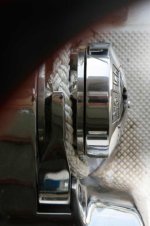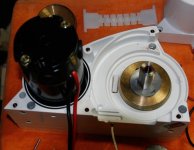After wrestling with my Lewmar Pro Fish 700 windlass on our CD 22 for 2 1/2 years, it finally froze up. The Lewmar never operated reliably on my setup as it required an unreasonable amount of finesse to move the rode in and out of the locker without it jumping off the gypsy or jamming. I plan to have Lewmar repair it and then sell it.
I did new research and selected the power up / power down, horizontal Maxwell HRC 6 windlass, although there seems to be other good alternatives as well. This unit draws more current and is more powerful than the Lewmar that it replaced. Here is a comparison of performance on my boat (I make no claims that this is typical and I understand that other folks have acceptable performance with their Lewmar Pro Fish). Note: no conclusion should be reached regarding Lewmar or Maxwell as a brand since specific units may be designed differently and will perform differently. Sorry about the table formatting, I had to use dashes to separate the Features, Lewmar and Maxwell ratings. Hope that you can follow it
FEATURE -Lewmar ProFish -Maxwell HRC 6
Control of the rode -Tenuous at best -Rock solid
Propensity of rode to jump gypsy -Mod. To High -Very Low even w/ slack
Speed of Pay out -Freefall is v. fast -Fast w/ no jam or jump
Speed of Retrieve -Rel. Fast -Rel. Fast
Sensitivity to rode splice -High -low
Sensitivity to rode slack -V. High -V. Low
Total Time to drop and set -Slow due to care required -Rel. Fast
Motor current switching -Special DPDT switch -HD Contactor + SPDT sw
Nominal Current draw -Approx 35A -Approx 45A
Minimum locker depth -approx 12 in. -approx 8 in.
In my opinion, the Lewmar ProFish freefall windlass has an inherent design flaw in that the finger that keeps the rode engaged with the gypsy teeth is lightly loaded and bounces around when paying out or retrieving.

Almost anything can cause the rode to jump and no slack can be tolerated. I assume that Lewmar chose this design because it puts very little drag on the rode as it free falls but at the expense of retaining engagement.


Note the nylon pressure arm which rides in a slot and engages the rode tightly.
The Maxwell has a very positive wrap around pressure arm made of nylon with a stainless steel backbone which holds the rode tight to the gypsy yet has enough resiliency to accommodate most rode and chain wear / irregularities.
I have seen numerous instances on different websites of the Lewmar locking up and this is collaborated by repair centers that I have contacted. The culprit seems to be water intrusion into the case or using the windlass to hold the boat against a heavy load instead of cleating the rode off.
A few more photos are shown in the C Eagle album here: http://www.c-brats.com/modules.php?set_ ... _album.php
The bottom line for my setup is that after 30 anchoring cycles, I have had zero jams or jumps with the Maxwell and the Lewmar never approached that level of troublefree performance.
I did new research and selected the power up / power down, horizontal Maxwell HRC 6 windlass, although there seems to be other good alternatives as well. This unit draws more current and is more powerful than the Lewmar that it replaced. Here is a comparison of performance on my boat (I make no claims that this is typical and I understand that other folks have acceptable performance with their Lewmar Pro Fish). Note: no conclusion should be reached regarding Lewmar or Maxwell as a brand since specific units may be designed differently and will perform differently. Sorry about the table formatting, I had to use dashes to separate the Features, Lewmar and Maxwell ratings. Hope that you can follow it
FEATURE -Lewmar ProFish -Maxwell HRC 6
Control of the rode -Tenuous at best -Rock solid
Propensity of rode to jump gypsy -Mod. To High -Very Low even w/ slack
Speed of Pay out -Freefall is v. fast -Fast w/ no jam or jump
Speed of Retrieve -Rel. Fast -Rel. Fast
Sensitivity to rode splice -High -low
Sensitivity to rode slack -V. High -V. Low
Total Time to drop and set -Slow due to care required -Rel. Fast
Motor current switching -Special DPDT switch -HD Contactor + SPDT sw
Nominal Current draw -Approx 35A -Approx 45A
Minimum locker depth -approx 12 in. -approx 8 in.
In my opinion, the Lewmar ProFish freefall windlass has an inherent design flaw in that the finger that keeps the rode engaged with the gypsy teeth is lightly loaded and bounces around when paying out or retrieving.

Almost anything can cause the rode to jump and no slack can be tolerated. I assume that Lewmar chose this design because it puts very little drag on the rode as it free falls but at the expense of retaining engagement.


Note the nylon pressure arm which rides in a slot and engages the rode tightly.
The Maxwell has a very positive wrap around pressure arm made of nylon with a stainless steel backbone which holds the rode tight to the gypsy yet has enough resiliency to accommodate most rode and chain wear / irregularities.
I have seen numerous instances on different websites of the Lewmar locking up and this is collaborated by repair centers that I have contacted. The culprit seems to be water intrusion into the case or using the windlass to hold the boat against a heavy load instead of cleating the rode off.
A few more photos are shown in the C Eagle album here: http://www.c-brats.com/modules.php?set_ ... _album.php
The bottom line for my setup is that after 30 anchoring cycles, I have had zero jams or jumps with the Maxwell and the Lewmar never approached that level of troublefree performance.
